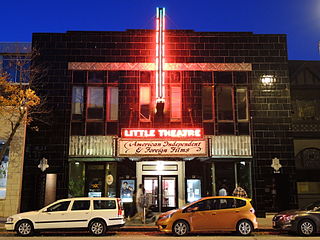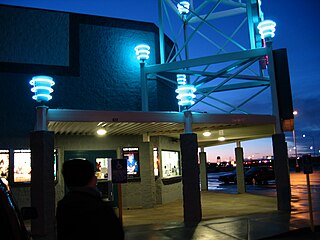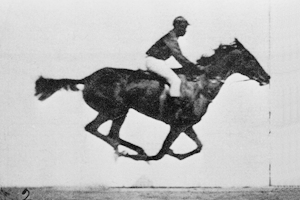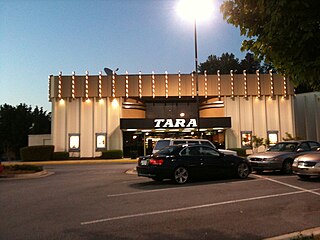
A movie theater, cinema, or cinema hall, also known as a picture house, the pictures, or the movies, is a building that contains auditoria for viewing films for entertainment. Most, but not all, theaters are commercial operations catering to the general public, who attend by purchasing a ticket. Some movie theaters, however, are operated by non-profit organizations or societies that charge members a membership fee to view films.

The cinema of the United States, often metonymously referred to as Hollywood, has had a large effect on the film industry in general since the early 20th century. The dominant style of American cinema is classical Hollywood cinema, which developed from 1913 to 1969 and characterizes most films made there to this day. While Frenchmen Auguste and Louis Lumière are generally credited with the birth of modern cinema, American cinema soon came to be a dominant force in the industry as it emerged. It produces the total largest number of films of any single-language national cinema, with more than 700 English-language films released on average every year. While the national cinemas of the United Kingdom (299), Canada (206), Australia, and New Zealand also produce films in the same language, they are not considered part of the Hollywood system. Hollywood has also been considered a transnational cinema. Classical Hollywood produced multiple language versions of some titles, often in Spanish or French. Contemporary Hollywood offshores production to Canada, Australia, and New Zealand.

AMC Theatres is a U.S.-based movie theater chain headquartered in Leawood, Kansas, and is the largest movie theater chain in the world. Founded in 1920, AMC has the largest share of the American theater market ahead of Cineworld and Cinemark Theatres.

The double feature, also known as a double bill, was a motion picture industry phenomenon in which theatre managers would exhibit two films for the price of one, supplanting an earlier format in which one feature film and various short subject reels would be shown.

IFC Center is an art house movie theater in Greenwich Village, Manhattan, New York City. Located at 323 Sixth Avenue at West 3rd Street, it was formerly the Waverly Theater, a well- known art house movie theater. IFC Center is owned by AMC Networks, the entertainment company that owns the cable channels AMC, BBC America, IFC, We TV and Sundance TV and the film company IFC Films.

The Little Theatre in Rochester, New York, commonly known as "The Little" is a movie theatre located on historic East Avenue in downtown Rochester, New York and a modest non-profit multiplex specializing in art film, including independent and foreign productions outside the United States.

The cinema of the Philippines began with the introduction of the first moving pictures to the country on January 1, 1897 at the Salón de Pertierra in Manila. following year, local scenes were shot on film for the first time by a Spaniard, Antonio Ramos, using the Lumiere Cinematograph. While most early filmmakers and producers in the country were mostly wealthy enterprising foreigners and expatriates, on September 12, 1919, Dalagang Bukid , a movie based on a popular musical play, was the first movie made and shown by Filipino filmmaker José Nepomuceno. Dubbed as the "Father of Philippine Cinema", his work marked the start of cinema as an art form in the Philippines.
The Philadelphia Film Festival is a film festival founded by the Philadelphia Film Society and is held in Philadelphia, Pennsylvania, United States. The festival is held at various theater venues throughout the Greater Philadelphia Area, including, the PFS Roxy Theater, Prince Theater, and Landmark Ritz Theaters. The festival features more than 200 films screenings with over 50 filmmakers and industry guests. The festival promotes films that may not be seen otherwise in the Philadelphia area.
Film distribution is the process of making a movie available for viewing by an audience. This is normally the task of a professional film distributor, who would determine the marketing strategy for the film, the media by which a film is to be exhibited or made available for viewing, and who may set the release date and other matters. The film may be exhibited directly to the public either through a movie theater or television, or personal home viewing. For commercial projects, film distribution is usually accompanied by film promotion.

A multiplex is a movie theater complex with multiple screens within a single complex. They are usually housed in a specially designed building. Sometimes, an existing venue undergoes a renovation where the existing auditoriums are split into smaller ones, or more auditoriums are added in an extension or expansion of the building. The largest of these complexes can sit thousands of people and are sometimes referred to as a megaplex.

Reel Theatres is a movie theater chain in the United States owned by Casper Management—an Idaho corporation—that features independent and foreign films. It operates theaters in Idaho, Oregon and Utah.

Film, also called movie or motion picture, is a visual art used to simulate experiences that communicate ideas, stories, perceptions, feelings, beauty or atmosphere by the means of recorded or programmed moving images along with other sensory stimulations. The word "cinema", short for cinematography, is often used to refer to filmmaking and the film industry, and to the art form that is the result of it.
The Christian film industry is an umbrella term for films containing a Christian themed message or moral, produced by Christian filmmakers to a Christian audience, and films produced by non-Christians with Christian audiences in mind. They are often interdenominational films, but can also be films targeting a specific denomination of Christianity.

The Baku Puppet Theatre is located on Neftchiler Avenue of Baku. It was built in 1910 by Polish architect Józef Płoszko, initially as the French Renaissance "Phenomenon" movie theater.

The Tara Theatre is an art house movie theater located in Atlanta. The theater specializes in the showing of independent films, the only theater in Atlanta to do so exclusively.

Bow Tie Cinemas is an American movie theater chain, with 38 locations in Colorado, Connecticut, Maryland, New Jersey, New York, and Virginia. As of 2013, it is the eighth-largest movie theater chain in the United States and is the oldest, having been founded in 1900. Bow Tie Cinemas is family-owned and has been for four generations.

An independent movie theater or indie cinema is a movie theater which screens independent, art house, foreign, or other non-mainstream films. They can be contrasted with mainstream cinemas, which are more likely to screen blockbusters and other popular films.

Nitehawk Cinema is a dine-in independent movie theater in Brooklyn, New York City. It operates two locations, in the neighborhoods of Williamsburg and Park Slope. The theater, which offers a menu of food and drinks that can be ordered and consumed while patrons view films, was the first liquor licensed movie theater in the state of New York, and the first movie theater in New York City to offer table service.













